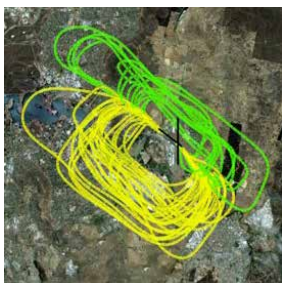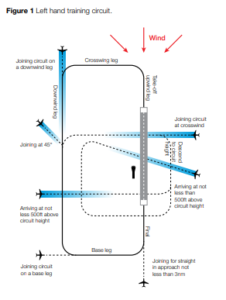Circuit training is the first stage of practical pilot training, focused on take-offs and landings. It involves the pilot making approaches to the runway, touching down and then applying power to take-off again.
Circuit training is undertaken at most airports, particularly regional and general aviation aerodromes. How a circuit is flown and its location is determined by the Civil Aviation Safety Authority.
The size and location of the circuit is controlled to ensure the safety of all aircraft operations at the airport. This may result in training being undertaken over populated areas, in close proximity to the airport.
Each airport makes its own decision about the hours of the day and days of the week during which training may take place. There are no regulated hours for circuit training,
This is usually based on:
- pilot demand
- the number and time of other scheduled flights into and out of the aerodrome
- runway capacity and configuration
- availability of air traffic control services
- the type of navigational equipment available at the aerodrome.
Training during both day and night is important for developing pilot competencies and experience using different types of navigational aids, however many airports prohibit circuit training at night and in the early morning. Airports publish this information on their websites.
For safety reasons, aircraft that are landing at non-controlled aerodromes are advised to use a circuit pattern on approach. This means that it may sometimes appear that aircraft are circuit training out of hours, when in fact they are following prescribed procedures for landing.
As different airports have different facilities, the numbers and timing of circuit training flights varies between locations.
A typical training circuit consists of five legs - the take-off, crosswind, downwind, base and final approach to the runway. The take-off and final stage of the circuit is usually flown into the wind, as this is the safest way for an aircraft to operate.
The direction of the training circuit depends on local terrain, weather and the position of the runway/s at the airport.
The yellow circuit shows circuits when the wind is blowing from the north, whereas the green circuit shows circuits when the wind is from the south.

Left hand circuits
A left hand circuit has the aircraft turning left after take-off and flying anticlockwise. This is the most common type of circuit operation. The aircraft symbols and dotted lines indicate recommended ways for an aircraft to join the circuit pattern.

Right hand circuits
Where a right hand circuit is used, a pilot turns right after take-off for a clockwise circuit. This may occur because of high terrain restricting circuit operations to one side of the runway, regardless of the wind direction. Right hand circuits may also be used at airports with parallel runways, such as Bankstown, Moorabbin and Parafield. During air traffic control service hours, circuit operations can be conducted off both parallel runways at the same time. This means both left and right hand circuits may be flown at the same time.
At locations with an air traffic control tower, pilots must follow the instructions of air traffic control on the height to fly and how to join and depart a circuit.
At airports without an air traffic control tower, Civil Aviation Safety Authority regulations say how an aircraft should join a circuit when approaching the airport. Arrival paths in the circuit have been designed to give pilots the best visibility of other aircraft in the circuit or approaching the airport from outside the circuit. Aircraft usually fly over the runway (at least 500 feet above the circuit) or join the circuit at the beginning, end, or partway along the downwind leg (at a 45 degree angle). If the circuit is clear, an arriving aircraft can join the final approach from three nautical miles (5.6 kilometres) out.
Aircraft can depart from the circuit by extending one of the four legs and are only allowed to turn away from the extended leg when well clear of the circuit.
The circuit length, and therefore the area overflown, depends on how quickly the aircraft can climb to the required height for the downwind leg. This length varies between aircraft and is affected by meteorological conditions (including wind, cloud cover, and temperature), other aircraft in the circuit, air traffic control requirements and pilot proficiency.
There are different categories of training aircraft based on the aircraft's speed. Each category has a different downwind height requirement measured above the ground level at the airport. This helps separate aircraft that perform differently. Higher performance aircraft fly larger and longer circuits at higher altitudes than lower performance aircraft.
Aircraft doing circuit training at airports without an air traffic control tower need to give way to commercial aircraft, such as scheduled flight operations. If this happens the training aircraft will extend one of the circuit legs to allow the commercial aircraft to land.
Training aircraft are certified to international noise standards which are implemented in Australia through the Air Navigation (Aircraft Noise) Regulations 2018.
These noise standards apply to the design and production of aircraft and specify the amount of noise that may be made by an aircraft model/ type. The regulations are administered by the Department of Infrastructure, Transport, Regional Development, Communications, Sport and the Arts.
Several airports and airfields have established voluntary Fly Neighbourly Advice or Fly Neighbourly Agreements. These are established between aircraft operators and communities or authorities (normally airports or local councils) to assist in reducing the impact of aircraft noise on local communities.
Information on Fly Neighbourly Agreements is available on airport websites.